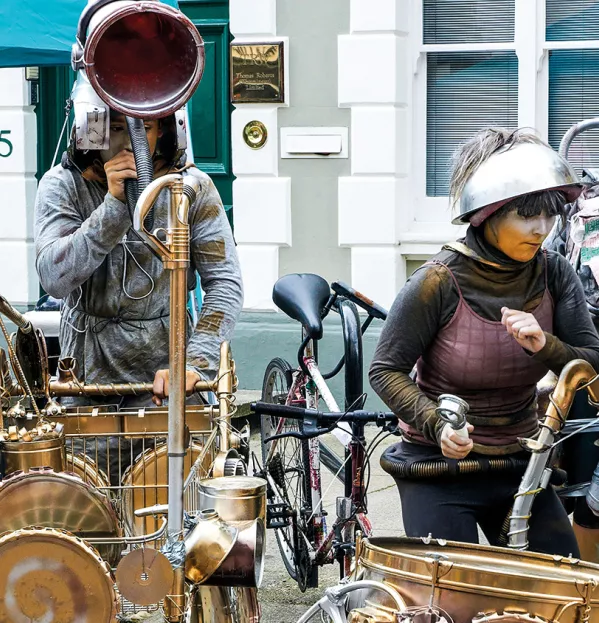How improv can dramatically improve your lessons

The audience is attentive as the two figures walk into the small “performance” space and wait. A location is soon shouted by someone near the front: “Halfway up Mount Everest!” Suddenly, the figures are in motion. Using just three words (“listen”, “look” and “AVALANCHE!” ) and a lot of mime, they create a short scene for those watching.
The audience laughs. A lot. They clap the performers at the end. And then the two figures retreat and two more enter the performance space.
This may sound like an improv night at a trendy London comedy bar, but it’s not: it’s my Year 6 classroom.
Flashback to September last year. A negative atmosphere seeped from every corner and pencil pot in the classroom. Low-level disruption, fidgeting, hissed nasty comments across tables - this was a class in crisis. But digging a little deeper, I discovered that it was all a smokescreen for the underlying issue of low self-worth. When discussing wrong behaviour choices, one child shrugged, “What’s the point? I’m going to fail my Sats anyway.”
What do you do with a class at this point?
In more than 30 years of teaching, drama has always been my secret weapon in turning around the most challenging classes. And this one had several elements that would lend themselves to drama: they had a great sense of humour, a tremendous energy and great enthusiasm when a fact or idea caught their imagination.
But what sort of drama was I going to do with them? Improv.
Improv is more than just “make up a scene as you go along”. Apart from a specific set of acting techniques, improv requires trust. And trust was what I decided this class needed the most. Developing trust between class members and between the class and me through improv would, I believed, have a positive impact on behaviour.
But this was not my only driver. Improv is based on reaction. The audience or group members make suggestions for content in the moment, meaning improvisers have to think on their feet - and this class were experts at that. In addition, to respond appropriately to what is being said in a scene or a game, listening skills are essential and need to be developed. My class needed those skills.
Finally, improv uses a lot of physicality - facial expressions, body expressions and movement. Just right for fidgety class members who find it impossible to sit still.
I told the class what I was going to and why I was going to do it. I told them that the exercises we would be doing would be from the adult improv group I attended - this would be serious stuff! And then ground rules were established: for example, the class suggested time out for anyone who did not show respect by shouting out or distracting others. I also committed to being an active part in every session - it was important for the class to see we were all in this together.
Initially, I timetabled games, finishing a lesson five minutes earlier. Games involved the whole class and were adapted so they could be done sitting (or standing) at tables.
What sort of exercises did we run? An early one was the “magical museum”. The children in turn described one exhibit that might be on display. One child chose a football, another chose the glittery teardrop of a lonely unicorn. They had to describe these exhibits in a dramatic voice. They (mostly) loved it.
The most important rule was that there were no wrong answers. Children who did not want to join in said “pass” and the game continued. These children were actively involved in other ways: suggesting ideas for scenes or being a referee in challenge games.
A non-threatening, supportive environment grew over time. Soon, all the class were actively participating. In the new year, I pushed things even further. I started a weekly lunchtime improv club and three-quarters of the class regularly attended. In each session, a short-form improvisation was the end product, using skills developed through group and pair work.
In class, improv activities began to focus on higher-level practical skills, such as character development and scene structure. Terminology was introduced and used in context: denial, acceptance, stereotype, motivation. The class realised that not every scene or comment had to make people laugh, and that if an activity didn’t work, it was better to discuss why rather than carry on. Scenes no longer involved three people speaking at once - in class, too, the shouting out had diminished.
Indeed, the class was being transformed. Children who were previously reluctant to speak in class performed in front of the school in a full-length improv showcase. Improv techniques had a positive impact on behaviour, as shown by the reduction of incidents recorded weekly.
My challenging class had changed. But improv gave us so much more than a decrease in disruption.
“No one else in the school can do what we do,” one child proudly announced at the leavers’ celebration.
I look back on that Year 6 with fond memories. We were a great team.
Rita Pike is a Year 6 teacher on Merseyside
This article originally appeared in the 21 February 2020 issue under the headline “Having problems with a disruptive class? Improvise ...”
You need a Tes subscription to read this article
Subscribe now to read this article and get other subscriber-only content:
- Unlimited access to all Tes magazine content
- Exclusive subscriber-only stories
- Award-winning email newsletters
Already a subscriber? Log in
You need a subscription to read this article
Subscribe now to read this article and get other subscriber-only content, including:
- Unlimited access to all Tes magazine content
- Exclusive subscriber-only stories
- Award-winning email newsletters